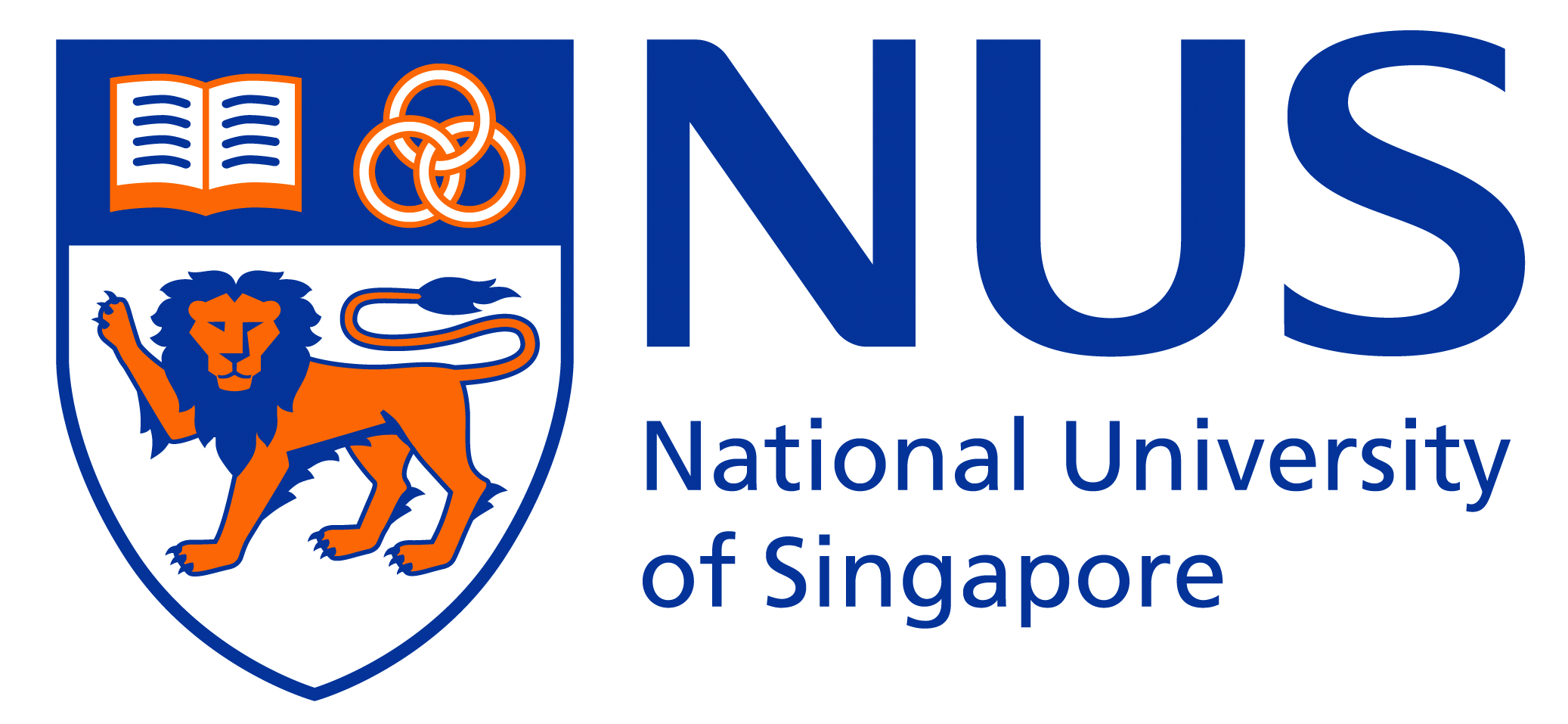|
|
| |
Welcome to the Ultracold Quantum Matter Group!.
We are performing experiments to explore many body quantum physics with ultracold atoms and molecules. We are located at the Centre for Quantum Technologies (CQT) hosted by the National University of Singapore.
We have an open postdoc position.
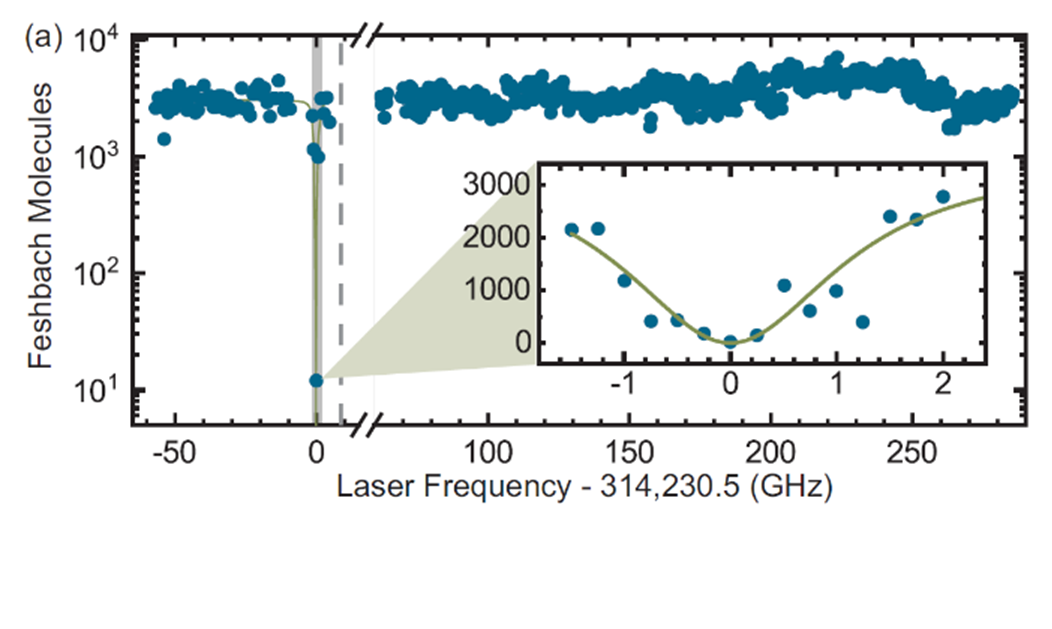
|
Finding magic wavelength transition
The narrow transition from the lowest rovibrational level of the |X1S+> electronic ground state to the lowest vibrational level of the |b3Π0> potential provides opportunities for achieving magic-wavelength trapping of ultracold bialkali molecules for enhancing their rotational coherence times. Guided by existing spectroscopic data of several perturbed and deeply-bound rovibrational states of the |A1S+> potential [Grochola et al., Chem. Phys. Lett., 2012, 535, 17-20], we conducted a targeted spectroscopic search and report the first observation of the lowest vibrational level of the |b3Π0> state in 6Li40K. The transition frequency from |X1S+,v=0,J=0> to |b3Π0, v'=0, J'=1> is determined to be 314,230.5(5) GHz. Assisted by microwave spectroscopy, we resolved the rotational structure of |b3Π0,v'=0> and extracted a rotational constant of h x 8.576(44) GHz for the |b3Π0> state. From this, we deduced an energy separation between |b3Π0,v'=0,J'=0> and |X1S+,v=0,J=0> of hc x 10,481.03(2) cm-1. Our work provides timely and precise information on the deeply-bound region of the |b3Π0> triplet excited potential of LiK, and benefits future applications of ultracold LiK isotopologues in quantum simulation and quantum computation that demand long coherence times.
Perturbation-assisted Observation of the Lowest Vibrational Level of the b 3 Π 0 State of Ultracold LiK Molecules, Anbang Yang, Xiaoyu Nie, Hao Lin Yu, Yiming Liu, Victor Avalos, Canming He, Jacek Klos, Svetlana Kotochigova, and Kai Dieckmann, arXiv.2510.17166, to be publisheed in PCCP.
|
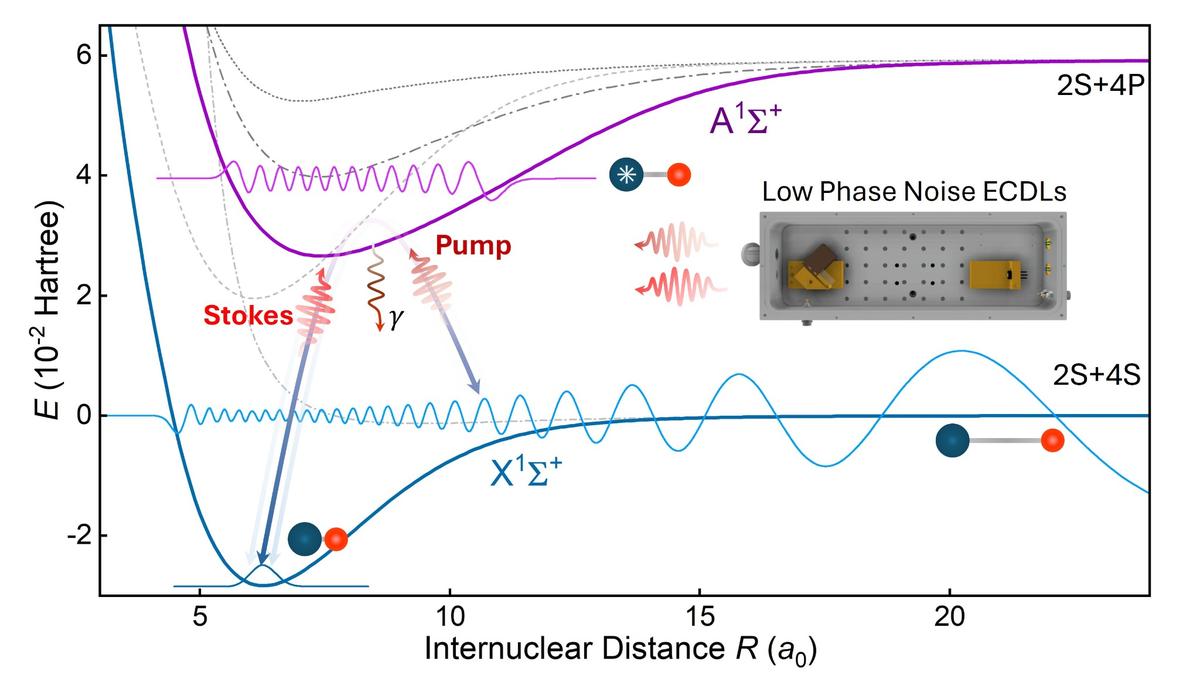
|
Improving STIRAP efficiency
Ultracold polar molecules represent a rapidly advancing platform at the forefront of quantum simulation, quantum computation, quantum chemistry, and precision measurement. We report an experimental investigation for improving the creation efficiency of ultracold 6Li40K ground state molecules using stimulated Raman adiabatic passage (STIRAP). We address laser amplitude/phase noise and polarization impurity to improve STIRAP efficiency. The phase noise of our two Raman lasers is suppressed effectively by extending the cavity length for the external-cavity diode lasers. Further, we find that even a weak polarization impurity significantly reduces the STIRAP efficiency on the single-photon resonance (Δ=0) for 6Li40K, due to coupling to undesired molecular levels. However, STIRAP efficiencies over 90% can be achieved by increasing Δ/2π to 10 MHz, which is comparable to the excited-state scattering rate. Our work holds significance for achieving efficient STIRAP transfer in ultracold molecules with unresolved excited state hyperfine splittings and large scattering rates.
Improving the Stimulated-Raman Adiabatic Passage Efficiency for Ultracold 6Li 40K Ground State Molecules, A. Yang, C. He, X. Nie, V. Avalos, S. Botsi, S. Kumar, and K. Dieckmann, Communications Physics, 8, 399, (2025), DOI.
|
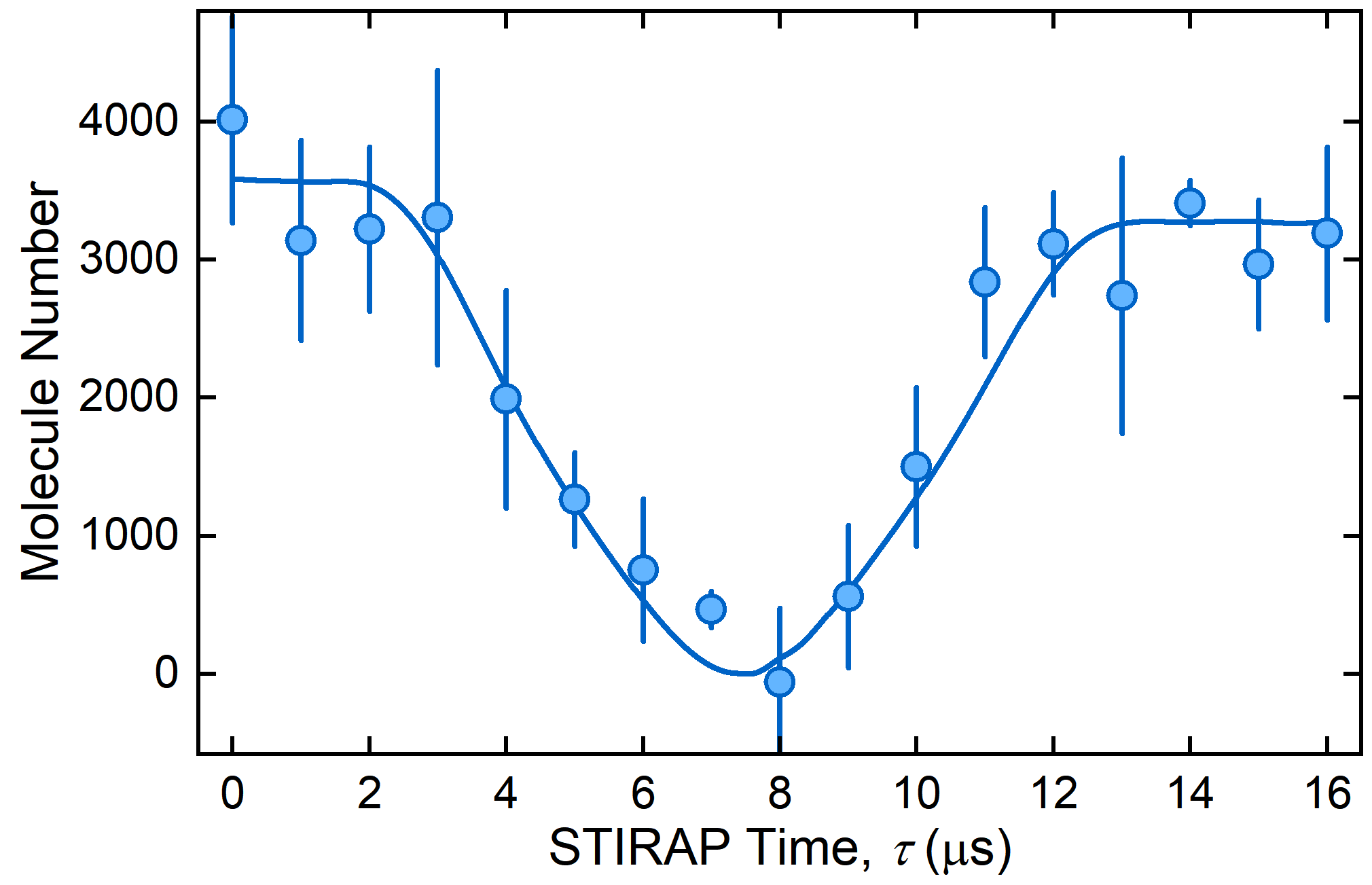
|
Ground state polar molecules
We report the creation of ultracold ground state 6Li40K polar molecules with high efficiency. Starting from weakly-bound molecules state, stimulated Raman adiabatic passage (STIRAP) is adopted to coherently transfer the molecules to their singlet ro-vibrational ground state |X1S+,v=0,J=0>. By employing a singlet STIRAP pathway and low-phase-noise narrow-linewidth lasers, we observed a one-way transfer efficiency of 96(4)%. Held in an optical dipole trap, the lifetime of the ground-state molecules is measured to be 5.0(3) ms. The large permanent dipole moment of LiK is confirmed by applying a DC electric field on the molecules and performing Stark shift spectroscopy of the ground state. With recent advances in the quantum control of collisions, our work paves the way for exploring quantum many-body physics with strongly-interacting 6Li40K molecules.
Efficient Creation of Ultracold Ground State 6Li 40KPolar Molecules, C. He, X. Nie, V. Avalos, S. Botsi, S. Kumar, A. Yang, and K. Dieckmann, Phys. Rev. Lett., 132, 243401 (2024), DOI.
|

|
FPGA based servo
We present the comparison of a field-programmable-gate-array (FPGA) based digital servo module with an analog counterpart for the purpose of laser frequency stabilization to a high-finesse optical cavity. The transfer functions of both the digital and analog modules for proportional-integral-derivative control are measured. For the lasers stabilized to the cavity, we measure the singe-sideband power spectral density of fast phase noise by means of an optical beat with filtered light transmitted through the cavity. The comparison between the digital and analog modules is performed for two low-phase-noise diode lasers at 1120 and 665 nm wavelengths. The performance of the digital servo module compares well to the analog one for the lowest attained levels of 30 mrad for the integrated phase noise and 10-3 for the relative noise power. The laser linewidth is determined to be in the sub-kHz regime, only limited by the high-finesse cavity. Our work exploits the versatility of the FPGA-based servo module (STEMlab) when used with open-source software and hardware modifications. We demonstrated that such modules are suitable candidates for remote-controlled low-phase-noise applications in the fields of laser spectroscopy and atomic, molecular, and optical physics.
Field-programmable-gate-array-based digital frequency stabilization of low-phase-noise diode lasers, V. Avalos, X. Nie, A. Yang, C. He, S. Kumar and K. Dieckmann, Review of Scientific Instruments, 94, 063001, (2023), DOI.
|
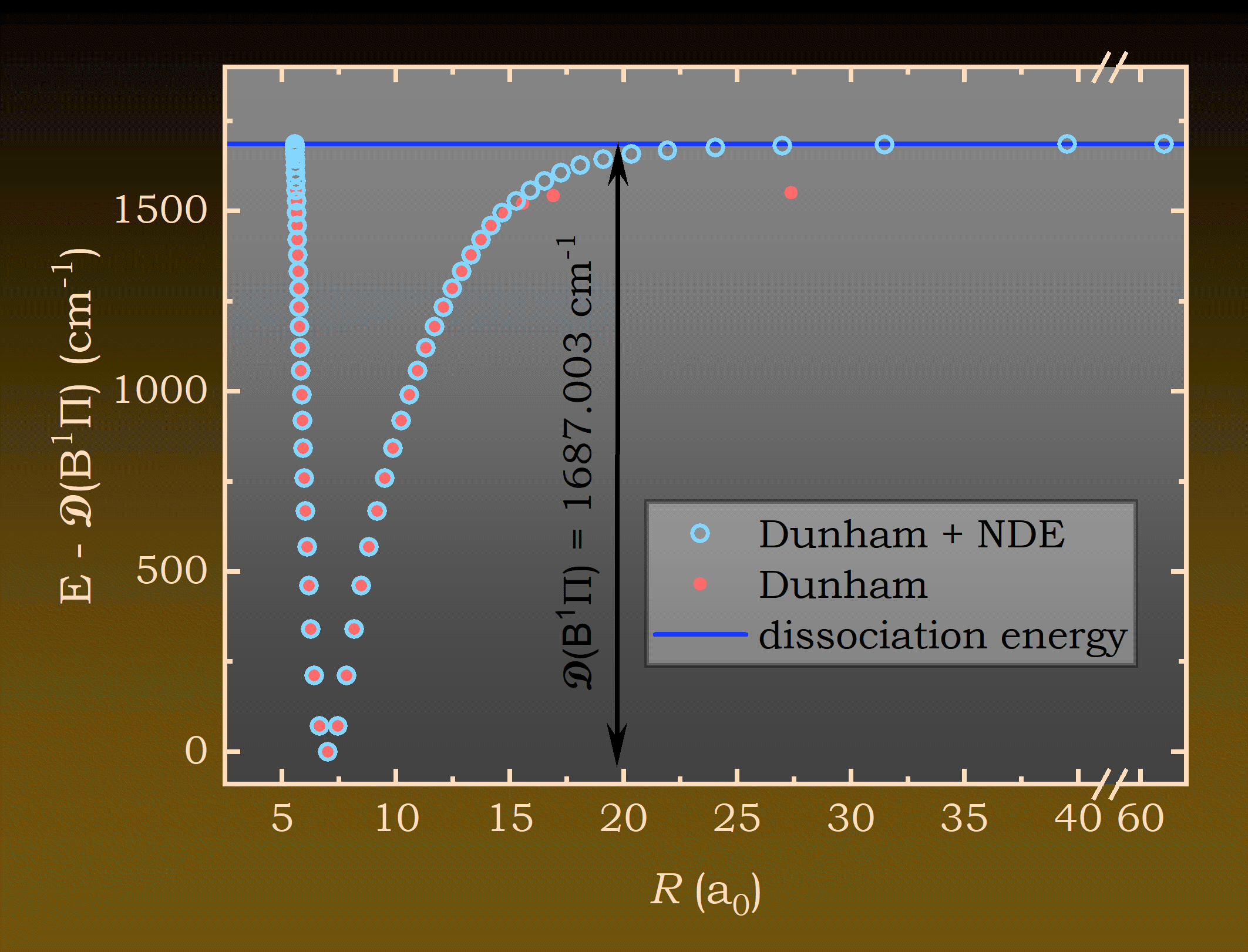
|
Long-Range Spectroscopy
We report on a high-resolution spectroscopic survey of 6Li40K molecules near the 2S+4P dissociation threshold and produce a fully empirical representation for the B1Π potential by connecting available short- and long-range data. The purpose is to identify a suitable intermediate state for a coherent Raman transfer to the absolute ground state, and the creation of a molecular gas with dipolar interactions. Starting from weakly bound ultracold Feshbach molecules, the transition frequencies to twenty-six vibrational states are determined. Our data are combined with long-range measurements [Ridinger et al., EPL, 2011, 96, 33001], and near-dissociation expansions for the spin-orbit coupled potentials are fitted to extract the C6 dispersion coefficients. A suitable vibrational level is identified by resolving its Zeeman structure and by comparing the experimentally attained g-factor to our theoretical prediction. Using mass-scaling of the short-range data for the B1Π [Pashov et al., Chem. Phys. Lett., 1998, 292, 615-620] and an updated value for its depth, we model the short- and the long-range data simultaneously and produce a Rydberg-Klein-Rees curve covering the entire range.
Empirical LiK excited state potentials: connecting short range and near dissociation expansions, S. Botsi, A. Yang, S. Kumar, S. B. Pal, M. M. Lam, M. Debatin, and K. Dieckmann, Physical Chemistry Chemical Physics, 24, 3933 - 3940, (2022), DOI.
|
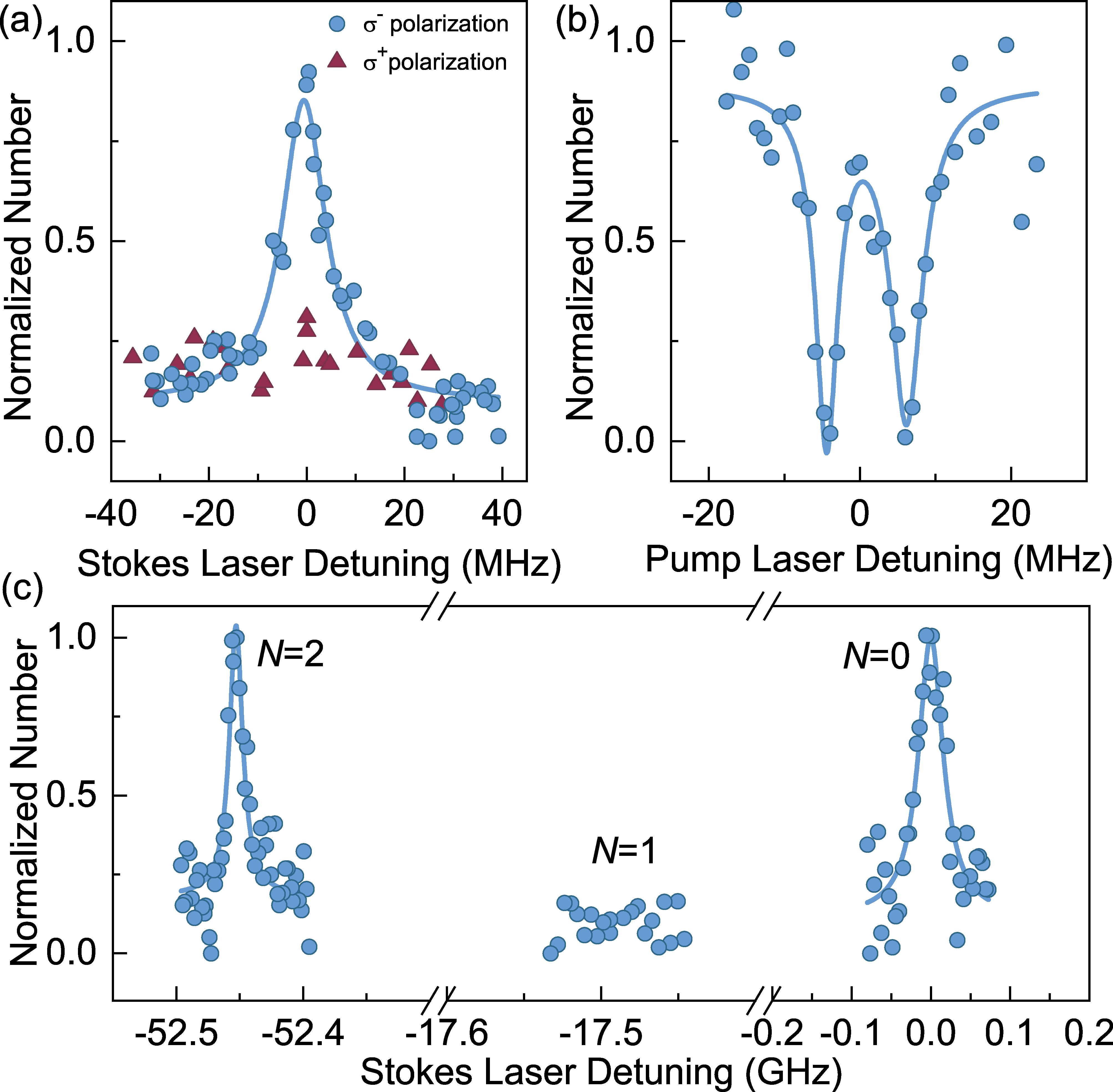
|
Singlet Pathway to the Ground State of Ultracold Polar Molecules
Starting from weakly bound Feshbach molecules, we demonstrate a two-photon pathway to the dipolar ground state of bi-alkali molecules that involves only singlet-to-singlet optical transitions. This pathway eliminates the search for a suitable intermediate state with sufficient singlet-triplet mixing and the exploration of its hyperfine structure, as is typical for pathways starting from triplet dominated Feshbach molecules. By selecting a Feshbach state with a stretched singlet hyperfine component and controlling the laser polarizations, we assure coupling to only single hyperfine components of the A1Σ+ excited potential and the X1Σ+ rovibrational ground state. In this way an ideal three level system is established, even if the hyperfine structure is not resolved. We demonstrate this pathway with 6Li40K molecules, and discuss its application to other important molecular species.
Singlet Pathway to the Ground State of Ultracold Polar Molecules, A. Yang, S. Botsi, S. Kumar, S. B. Pal, M. M. Lam, I. Cepaite, A. Laugharn, and K. Dieckmann, Phys. Rev Lett., 124, 133203 (2020), DOI.
|
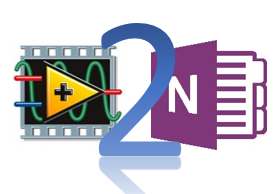
|
Automated lab journal
We updated our library to access Microsoft OneNote (Office 365) from LabView for automated lab journal writing. The current solution is based on OAuth 2.0.We share the code on GitHub.
|
|

|
Gray molasses cooling vs narrow-line cooling
We present an efficient scheme to implement a gray optical molasses for sub-Doppler cooling of Li atoms with minimum experimental overhead. To integrate the D1 light for the gray molasses (GM) cooling into the same optical set-up that is used for the D2 light for a standard magneto-optical trap (MOT), we rapidly switch the injection seeding of a slave laser between the D2 and D1 light sources. Switching times as short as 30 microseconds can be achieved, inferred from monitor optical beat signals. The resulting low-intensity molasses cools a sample of 9x108 atoms to about 60 microkelvin. A maximum phase-space density of 1.2x10-5 is observed. On the same set-up, the performance of the GM is compared to that of narrow-line cooling in a UV MOT. Further, we compare the production of a degenerate Fermi gas using both methods. Loading an optical dipole trap from the gray molasses yields a quantum degenerate sample with 3.3x105 atoms, while loading from the denser UV MOT yields 2.4x106 atoms. Where the highest atom numbers are not a priority this implementation of the gray molasses technique yields sufficiently large samples at a comparatively low technical effort.
Comparison of an efficient implementation of gray molasses to narrow-line cooling for the all-optical production of a lithium quantum gas, C. . L. Satteer, S. Tan, and Kai Dieckmann, Phys. Rev. A, 98, 023422, (2018), DOI. |
|
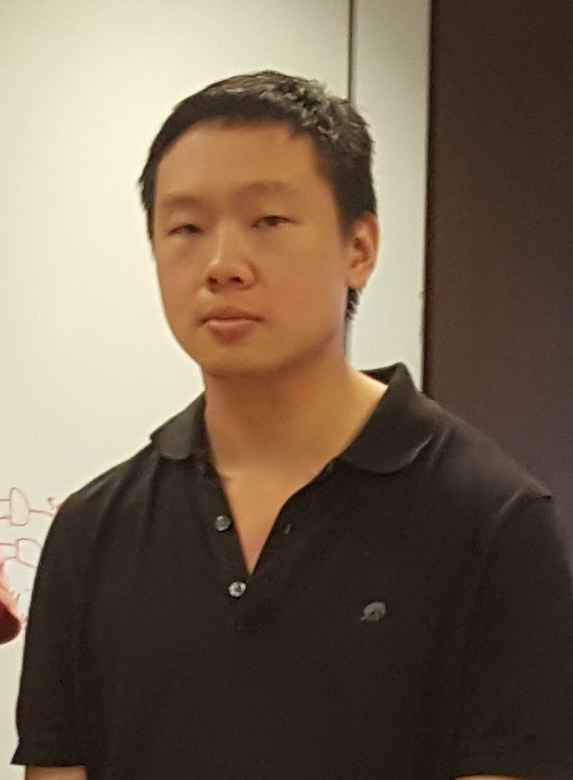
|
PhD thesis defense
Congratualtions to Mark Lam!
Spectroscopy of Ultracold 6Li40K Molecules, Mark Lam, Centre for Quantum Technologies, National University of Singapore, (2017).
|
|
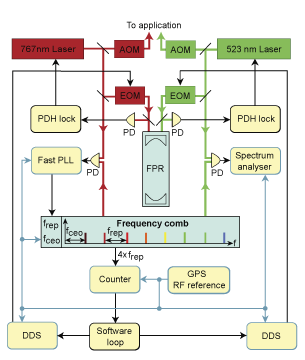
|
Make one laser lock get one for free
We report on a transfer-lock laser frequency stabilization that utilizes a frequency comb (FC) and a radio frequency counter referenced to a GPS frequency standard to compen-sate for the frequency drifts of two lasers, which are locked to a single passive Fabry-Perot resonator (FPR). The method requires only one optical phase lock with the FC and allows transfer locking of lasers at wavelengths beyond the usable range of the FC. To at-tain a large frequency tuning range for the lasers, we implement optical serrodyning. We further demonstrate an efficient scheme to suppress residual amplitude modulation, thereby improving the stability of the Pound-Drever-Hall lock used in this case. The abso-lute frequency stability was found to be better than 2x1013 on timescales up to 300s. Hence, together with the frequency stability on short timescales provided by the FPR, this scheme facilitates coherent Raman spectroscopy as needed for an example for the production of ultracold dipolar heteronuclear molecules.
|
|

|
ICOLS 2015 Proceedings published
The 22nd International Conference on Laser Spectroscopy (ICOLS) took place in Singapore on June 28 - Jul 3.
ICOLS features the latest developments in the area of laser spectroscopy and related topics in atomic, molecular, and optical physics and other disciplines. The talks covered a broad range of exciting physics, such as precision tests of fundamental symmetries with atoms and molecules, atomic clocks, quantum many-body physics with ultra-cold atoms, atom interferometry, quantum information science with photons and ions, quantum optics, and ultra-fast atomic and molecular dynamics.
|
|
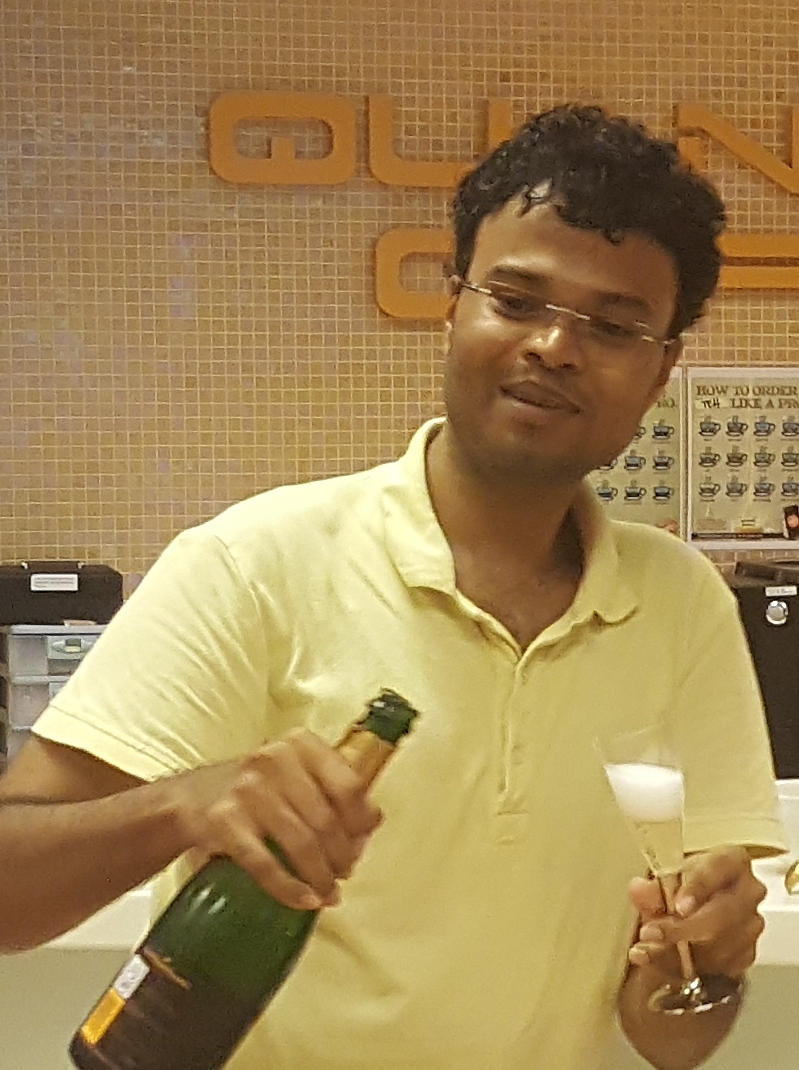
|
PhD thesis defense
Congratualtions to Sambit Pal!
Molecular Spectroscopy of Ultracold 6-lithium and 40-potassium molecules: Towards STIRAP Transfer to Absolute Ground State, Sambit B. Pal, Centre for Quantum Technologies, National University of Singapore, (2016).
|
|
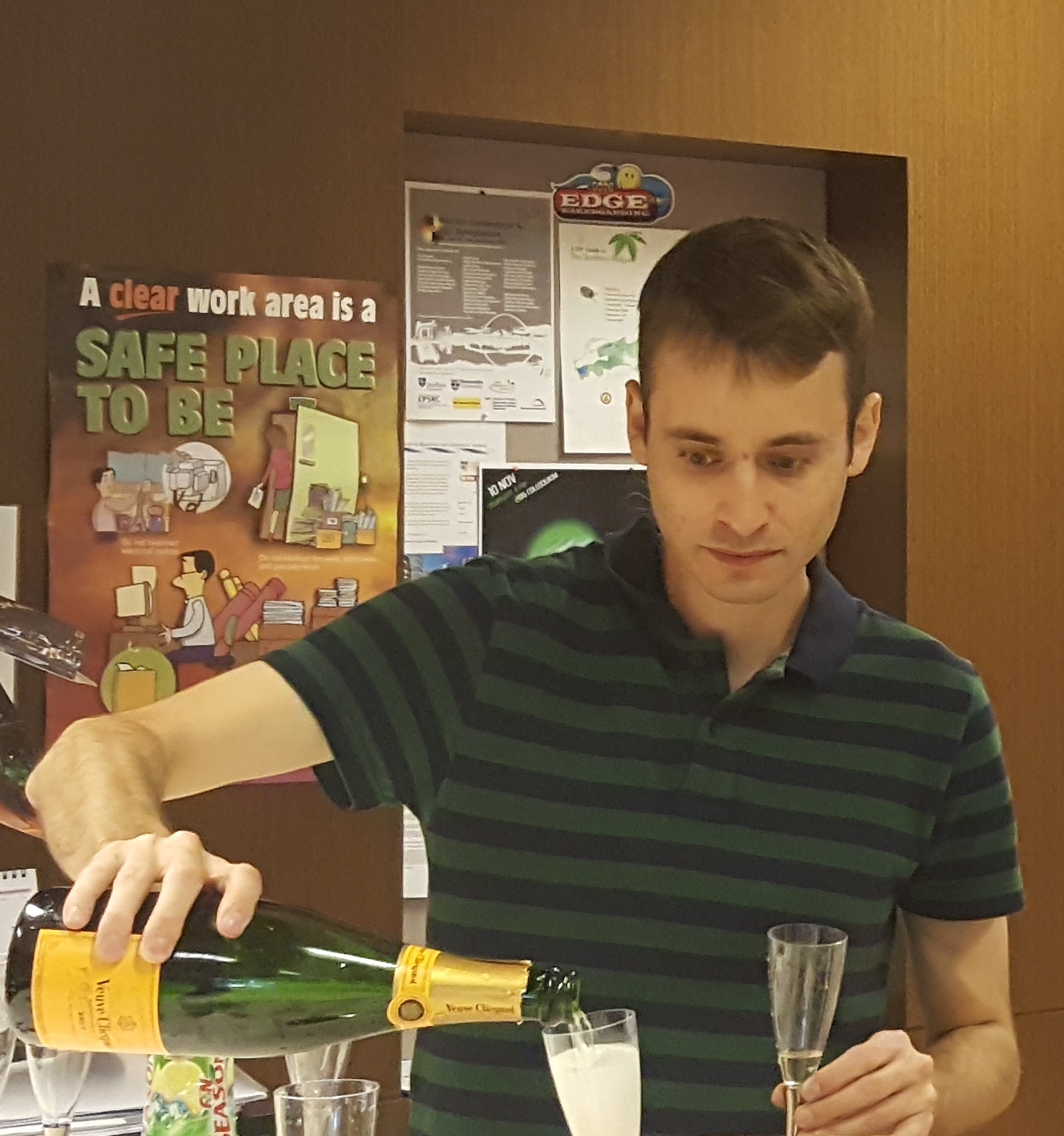
|
PhD thesis defense
Congratualtions to Christian Gross!
Atomic 2S 1/2 to 3P 3/2 Transition for Production and Investigation of a Fermionic Lithium Quantum Gas, Christian Gross, Centre for Quantum Technologies, National University of Singapore, (2016). Thesis. |
|

|
Ultracold dipolar molecules feature in roadmap on quantum systems
This roadmap bundles fast developing topics in experimental optical quantum sciences,
addressing current challenges as well as potential advances in future research. We have
focused on three main areas: quantum assisted high precision measurements, quantum
information/simulation, and quantum gases. Quantum assisted high precision
measurements are discussed in the first three sections, which review optical clocks, atom
interferometry, and optical magnetometry. These fields are already successfully utilized in
various applied areas. We will discuss approaches to extend this impact even further. In the
quantum information/ simulation section, we start with the traditionally successful
employed systems based on neutral atoms and ions. In addition, the marvelous
demonstrations of systems suitable for quantum information is not progressing, unsolved
challenges remain and will be discussed. We will also review, as an alternative approach,
the utilization of hybrid quantum systems based on superconducting quantum devices and
ultracold atoms. Novel developments in atomtronics promise unique access in exploring
solid-state systems with ultracold gases and are investigated in depth. The sections
discussing the continuously fast-developing quantum gases include a review on dipolar
heteronuclear diatomic gases, Rydberg gases, and ultracold plasma. Overall, we have
accomplished a roadmap of selected areas undergoing rapid progress in quantum optics,
highlighting current advances and future challenges. These exciting developments and vast
advances will shape the field of quantum optics in the future.
|
|
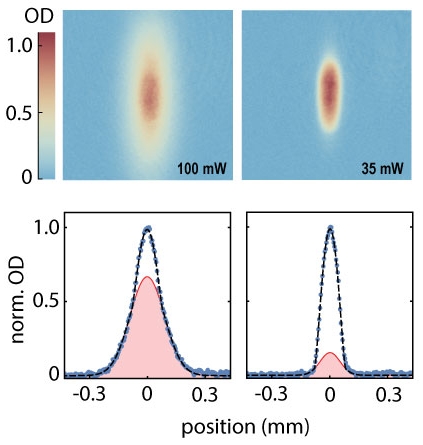
|
6Li molecular quantum gas in a large volume transport trap
We report on an efficient production scheme for a large quantum degenerate sample of fermionic lithium. The approach is based on our previous work on narrow-line 2S1/2→3P3/2 laser cooling resulting in a high phase-space density of up to 3x10-4. This allows utilizing a large volume crossed optical dipole trap with a total power of 45 W, leading to high loading efficiency and 8x106 trapped atoms. The same optical trapping configuration is used for rapid adiabatic transport over a distance of 25 cm in 0.9 s, and subsequent evaporative cooling. With optimized evaporation we achieve a degenerate Fermi gas with 1.7x106 atoms at a temperature of 60 nK, corresponding to T/TF=0.16(2). Furthermore, the performance is demonstrated by evaporation near a broad Feshbach resonance creating a molecular Bose-Einstein condensate of 3x105 lithium dimers.
All-optical production and transport of a large 6Li quantum gas in a crossed optical dipole trap , Ch. Gross, H. C. J. Gan, and K. Dieckmann, Phys. Rev. A, 93, 053424 (2016). |
|
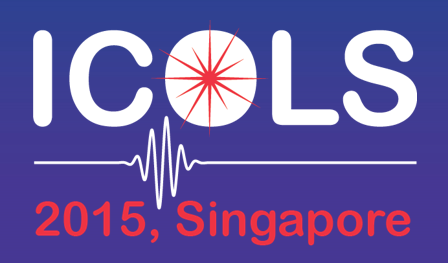
|
ICOLS 2015, Singapore
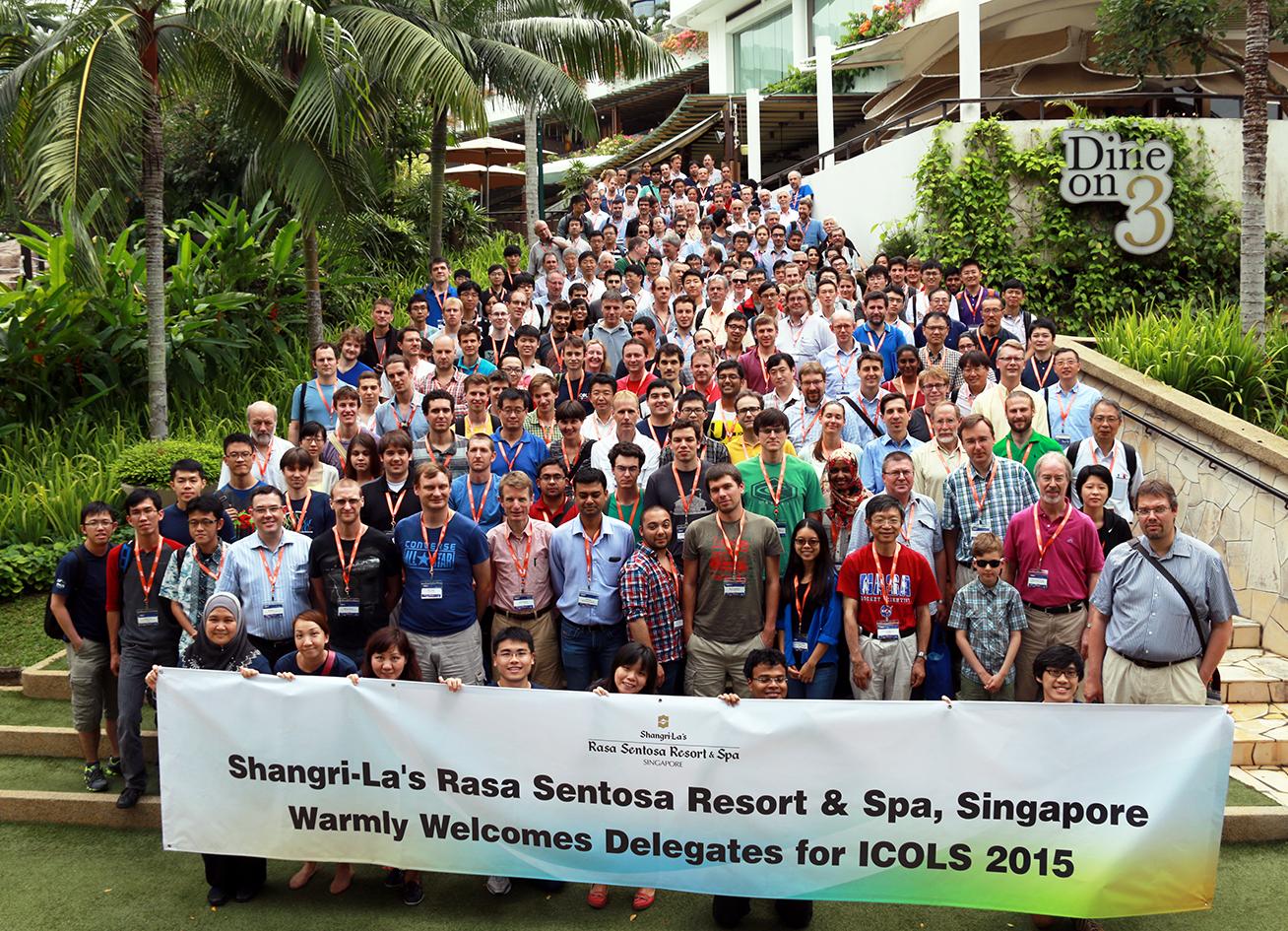
Thank you for travelling to Singapore and your contributions to a successful conference!
|
|
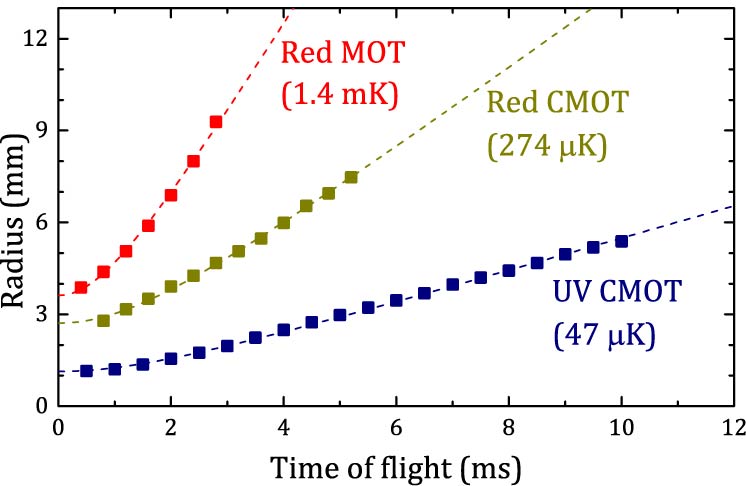
|
Narrow-line cooling of fermionic lithium
We report an experimental study of peak and phase-space density of a two-stage magneto-optical trap (MOT) of 6Li atoms, which exploits the narrower 2S1/2→3P3/2 ultra-violet (UV) transition at 323nm following trapping and cooling on the more common D2 transition at 671nm. The UV MOT is loaded from a red MOT and is compressed to give a high phase-space density up to 3x10-4. Temperatures as low as 33μK are achieved on the UV transition. We study the density limiting factors and in particular find a value for the light-assisted collisional loss coefficient of 1.3(±0.4)x10-10cm3/s for low repumping intensity.
Two-stage magneto-optical trapping and narrow-line cooling of 6Li atoms to high phase-space density , J. Sebastian, Ch. Gross, Ke Li, H. C. J. Gan, Wenhui Li, and K. Dieckmann, Phys. Rev. A, 90, 033417 (2014). |
|
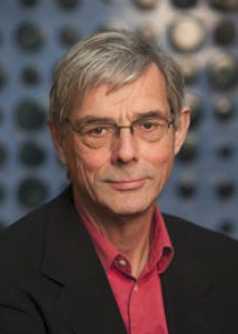
|
Guest Lecture Series by Prof. J.T.M. Walraven
Prof. Walraven, University of Amsterdam, is visiting our group from Jan until May, 2014. Throughout the semester he will teach this fully creditable module:
PC5239: "Quantum gases collisions and statistics"
This course introduces basic concepts of the physics of ultra-cold quantum gases - low-density gases of neutral atoms studied at (sub)microkelvin temperatures. Quantum gases are important both from the fundamental point of view and for their potential application in quantum information processing. The course is focused on quantum collisions and quantum statistics as these phenomena provide the underpinning for the very existence of the field. A systematic introduction is given into the quantum mechanics of low-energy collisions and the consequences of the quantum statistical nature of the collision partners for the behavior of the gas. The students will learn to distinguish between varieties of collisional phenomena and understand their consequences both from the kinetic and the thermodynamic point of view.
Module flyer.
|
|

|
ICOLS2015 in Singapore
|
|
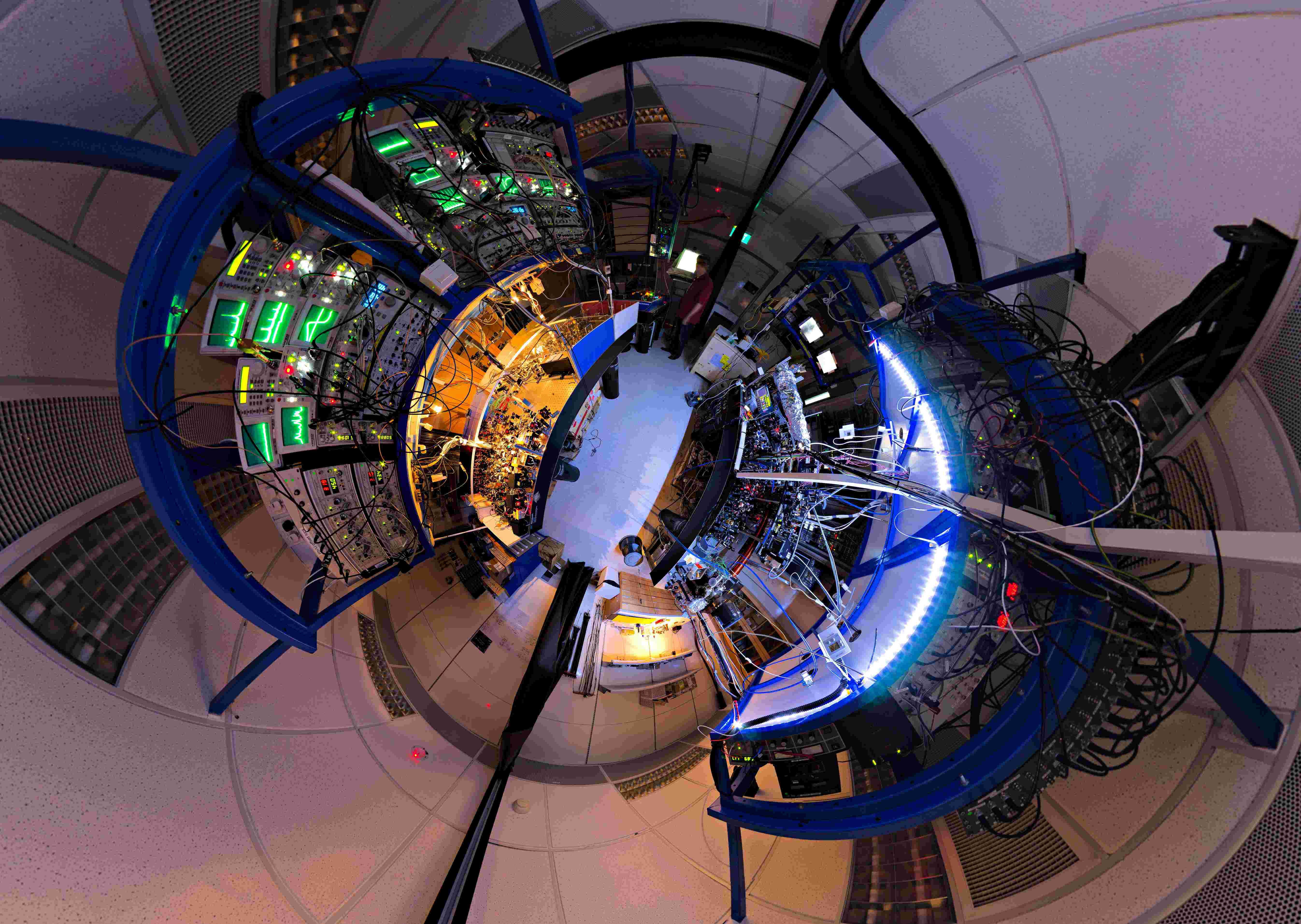
|
Streetview of our labs
CQT´s picture wizard Daniel Oi photorgraphed one of our labs with a wide angle lens, stitched the shots together, and made them available in streetview style. Zoom into our lab here.
|
|
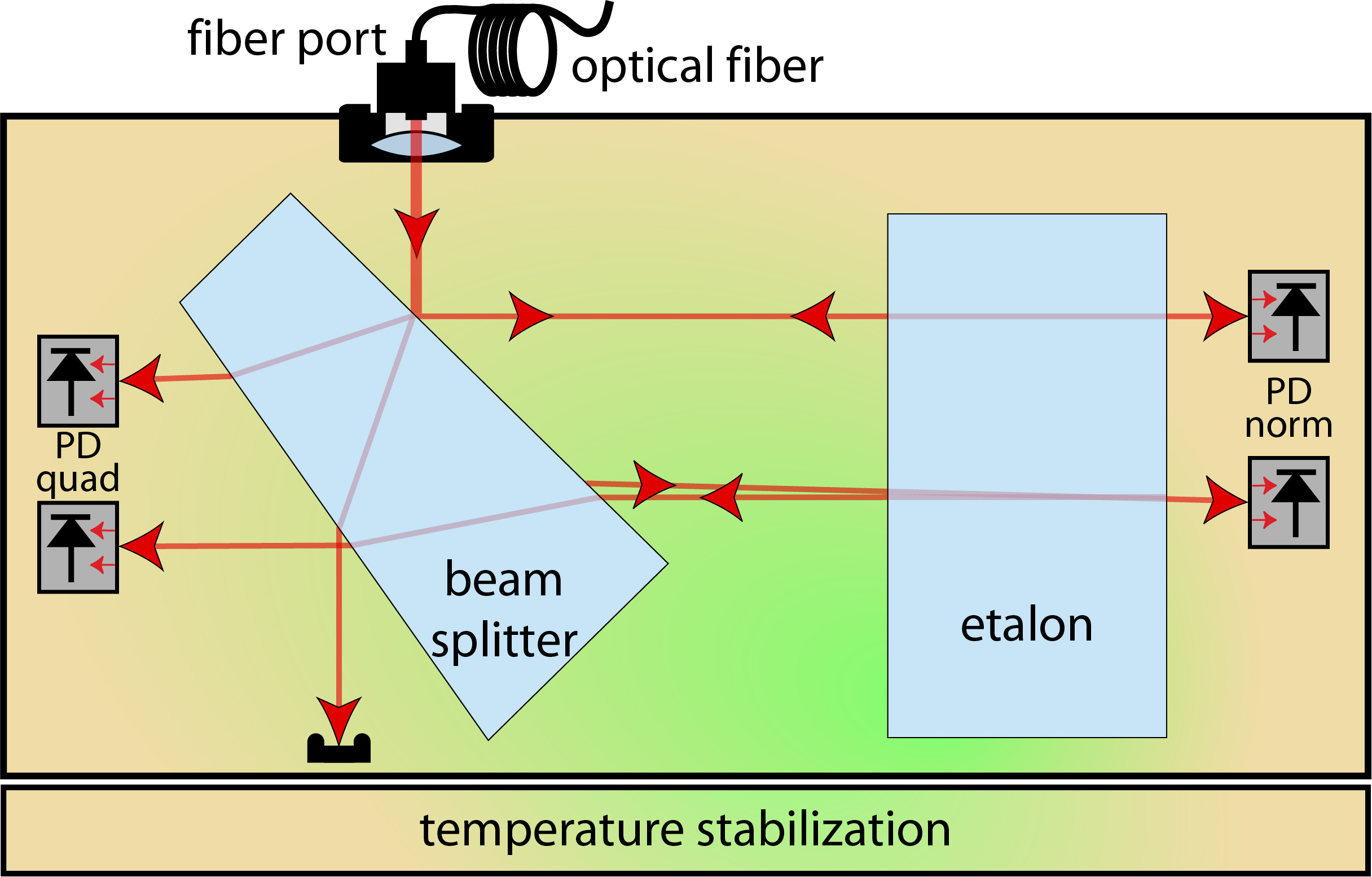
|
Megahertz precision wavelength measurement
In an industry collaboration with TEM Messtechnik GmbH, Hannover, Germany, we report on a calibration procedure that enhances the precision of an interferometer based frequency stabilization by several orders of magnitude. For this purpose, the frequency deviations of the stabilization are measured precisely by means of a frequency comb. This allows us to implement several calibration steps that compensate different systematic errors. The resulting frequency deviation is shown to be less than 5.7 MHz (rms 1.6 MHz) in the whole wavelength interval 750795 nm. Wide tuning of a stabilized laser at this exceptional precision is demonstrated.
|
|

|
Magic wavelengths for mass- and spin-imbalanced
mixtures in 1D optical lattices
In a collaborative theoretical study by researchers from Munich, Innsbruck, Bologna, Lyon, Wyoming, Santa Barbara, and Singapore we present a systematic investigation of attractive binary mixtures in the presence of both spin- and massimbalance
in one-dimensional setups described by the Hubbard model. After discussing typical cold atomic
experimental realizations and the relation between microscopic and effective parameters, we study several
many-body features of trapped Fermi-Fermi and Bose-Bose mixtures such as density profiles, momentum
distributions, and correlation functions by means of density-matrix-renormalization-group and quantum Monte
Carlo simulations. In particular, we focus on the stability of Fulde-Ferrell-Larkin-Ovchinnikov, dimer, and trimer
fluids in inhomogeneous situations, as typically realized in cold gas experiments due to the harmonic confinement.
We finally consider possible experimental signatures of these phases both in the presence of a finite polarization
and of a finite temperature.
Dimer, trimer, and Fulde-Ferrell-Larkin-Ovchinnikov liquids in mass- and spin-imbalanced
trapped binary mixtures in one dimension,
M. Dalmonte, K. Dieckmann, T. Roscilde, C. Hartl, A. E. Feiguin, U. Schollwck, and F. Heidrich-Meisner,
Phys. Rev. A 85, 063608, (2012). |
|
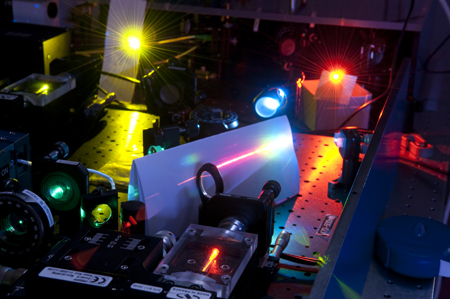
Image © Daniel Oi. |
Shared frequency comb system started operation
For our experiments with ultracold atoms and molecules we recently installed a commercial frequency comb system that can serve as a frequency reference for multiple application lasers. The system is operating in our lab and sharing the frequency comb with two other laboratories in CQT. We are using a sub-kiloherz linewidth diode laser stabilized to a highly stable optical reference resonator (design - courtesy by Max-Planck-Institute for Quantum Optics, Munich, Germany.) in order to improve the short time stability of the comb system.
|
|
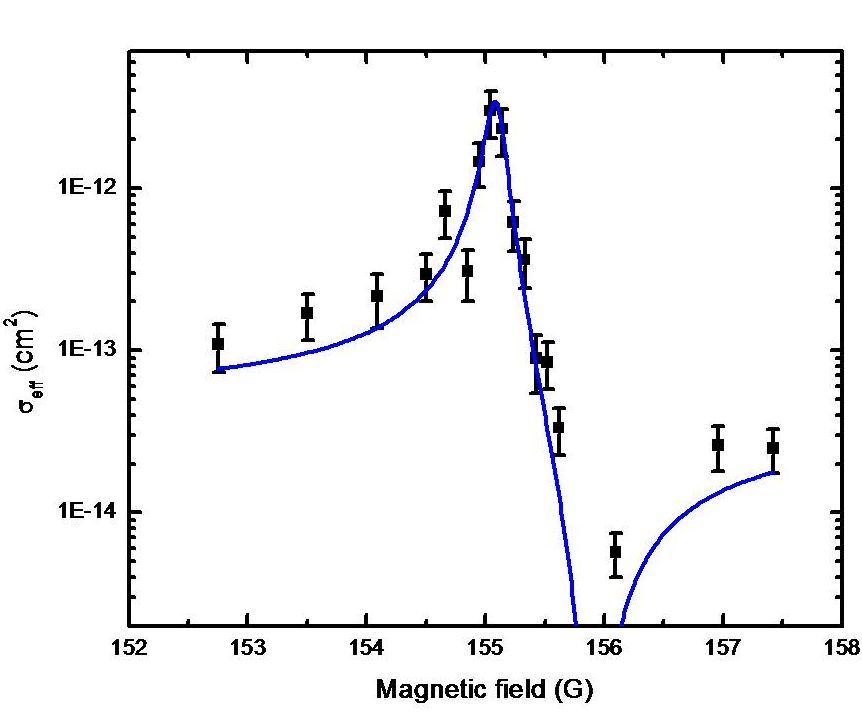
|
Narrow s-Wave Feshbach Resonance
We investigate s-wave interactions in a two-species Fermi-Fermi mixture of 6Li and 40K. We develop
for this case the method of cross-dimensional relaxation and find from a kinetic model, Monte Carlo
simulations, and measurements that the individual relaxation rates differ due to the mass difference. The
method is applied to measure the elastic cross section at the Feshbach resonance that we previously used
for the production of heteronuclear molecules. Location (B0=154.71(5) G) and width are determined for
this resonance. This reveals that molecules are being produced on the atomic side of the resonance within
a range related to the Fermi energies, therefore establishing the first observation of a many body effect in
the crossover regime of a narrow Feshbach resonance.
s-Wave Interaction in a Two-Species Fermi-Fermi Mixture at a Narrow Feshbach Resonance,
L. Costa, J. Brachmann, A.-C. Voigt, C. Hahn, M. Taglieber, T.W. Hänsch, and K. Dieckmann,
Phys. Rev. Lett. 105, 123201, (2010) |
|
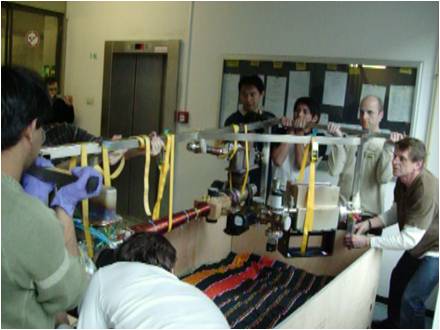 |
Transfer of Experiment from Munich to Singapore
In March 2010 we transfered the experimental setup from Munich to Singapore. The experiment had been developed in the group of Prof. Hänsch at the Ludwig-Maximilians-University of Munich.
|
|
 |
Stable Bosonic Heteronuclear Molecules
We report on the first creation of ultracold bosonic heteronuclear molecules of two fermionic species, 6Li and 40K, by a magnetic field sweep across an interspecies s-wave Feshbach resonance. This allows us to associate up to 4×104 molecules with high efficiencies of up to 50%. Using direct imaging of the molecules, we measure increased lifetimes of the molecules close to resonance of more than 100ms in the molecule-atom mixture stored in a harmonic trap.
Ultracold Heteronuclear Fermi-Fermi Molecules,
A.-C. Voigt, M. Taglieber, L. Costa, T. Aoki, W. Wieser, T. W. Hänsch, and K. Dieckmann,
Phys. Rev. Lett. 102, 020405, (2009)
Science Editors Choice (Science, 323, (2009), p563)
Online article in Pro-Physik: Ultrakalte Molekle aus ungleichen Fermi-Atomen |
|
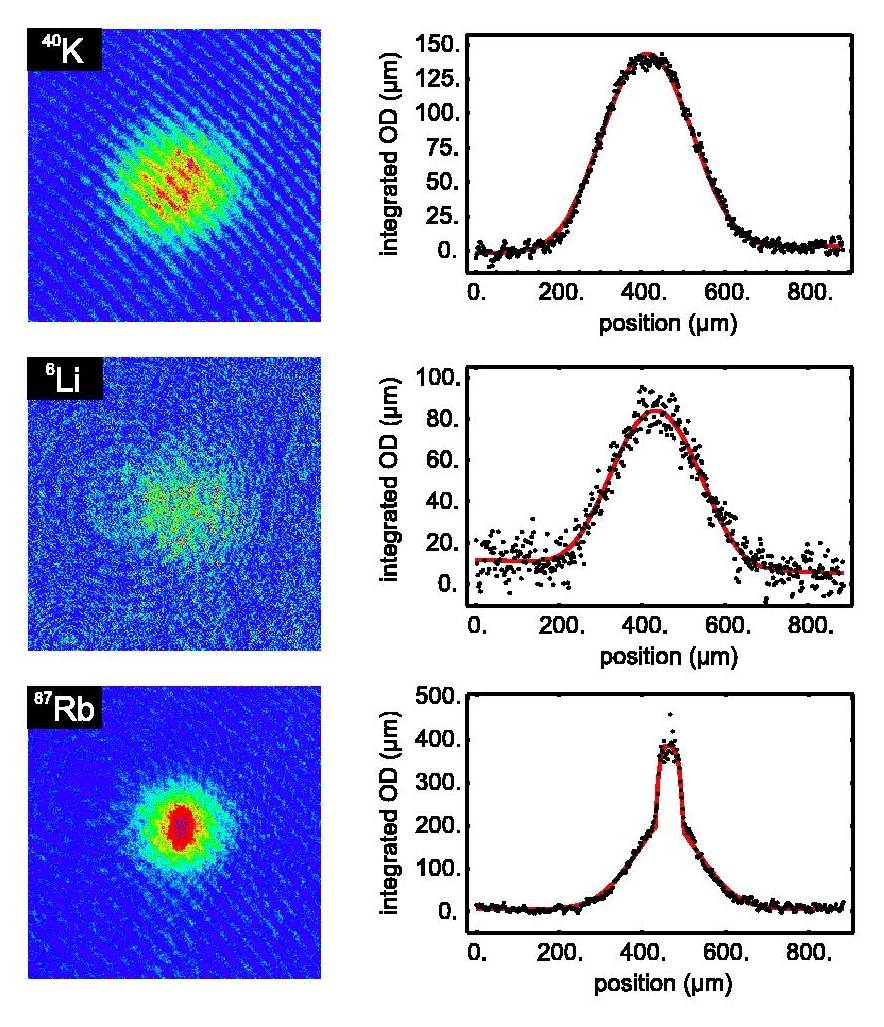 |
Quantum Degeneracy in Fermi-Fermi Mixture
We report on the generation of a quantum degenerate Fermi-Fermi mixture of two different atomic species. The quantum degenerate mixture is realized employing sympathetic cooling of fermionic 6Li and 40K gases by an evaporatively cooled bosonic 87Rb gas. We describe the combination of trapping and cooling methods that proved crucial to successfully cool the mixture. In particular, we study the last part of the cooling process and show that the efficiency of sympathetic cooling of the 6Li gas by 87Rb is increased by the presence of 40K through catalytic cooling. Because of the differing physical properties of the two components, the quantum degenerate 6Li-40K Fermi-Fermi mixture is an excellent candidate for a stable, heteronuclear system allowing the study of several so far unexplored types of quantum matter.
Quantum Degenerate Two-Species Fermi-Fermi Mixture Coexisting with a Bose-Einstein Condensate,
M. Taglieber, A.-C. Voigt, T. Aoki, T. W. Hänsch, and K. Dieckmann,
Phys. Rev. Lett. 100, 010401, (2008)
|
|
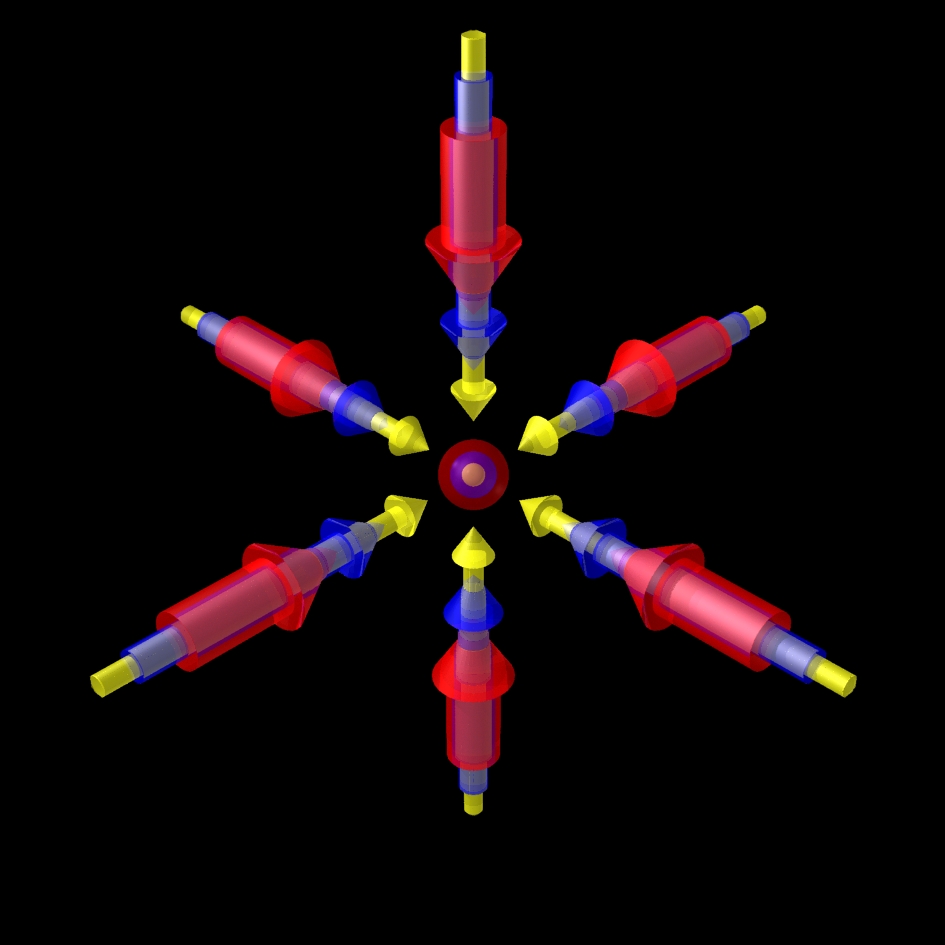 |
Triple Magneto-Optical Trap
We report on the simultaneous trapping of two fermionic species, 6Li and 40K, and a bosonic species, 87Rb
demonstrating the first three-species magneto-optical trap: "Triple MOT". The apparatus including the atom
sources and the three laser systems is described, and the single-species MOTs and the triple MOT are characterized.
In triple MOT operation, typical atom numbers of 3.2×107 for 6Li, 1.5×107 for 40K, and 5.4×109 for 87Rb were achieved. Trap loss due to interspecies collisions was observed.We describe our way to optimize the
triple MOT and turn it into a suitable source for the goal to achieve quantum degeneracy by evaporative and
sympathetic cooling.
Quantum Degenerate Two-Species Fermi-Fermi Mixture Coexisting with a Bose-Einstein Condensate,
M. Taglieber, A.-C. Voigt, F. Henkel, S. Fray, T. W. Hänsch, and K. Dieckmann,
Phys. Rev. A. 73, 011402(R), (2006)
|
|
|
|

